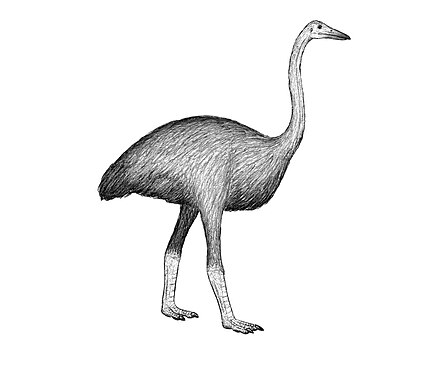Elephant bird
Elephant birds are members of the extinct ratite family Aepyornithidae, made up of large to enormous flightless birds that once lived on the island of Madagascar. They became extinct, perhaps around 1000–1200 AD, probably as a result of human activity. Elephant birds comprised the genera Mullerornis, Vorombe and Aepyornis. While they were in close geographical proximity to the ostrich, their closest living relatives are kiwi (found only in New Zealand), suggesting that ratites did not diversify by vicariance during the breakup of Gondwana but instead evolved from ancestors that dispersed more recently by flying.
In September 2018, scientists determined that Vorombe titan reached weights of 730 kg (1,600 lb) and stood 3 m (9.8 ft) tall, making it the world's largest (heaviest) bird, slightly larger than the much older Dromornis stirtoni.
Elephant birds have been extinct since at least the 17th century. Étienne de Flacourt, a French governor of Madagascar in the 1640s and 1650s, mentions an ostrich-like bird said to inhabit unpopulated regions, though it is unclear whether he was repeating folk tales passed on from generations earlier. In 1659, Flacourt wrote of the "vouropatra – a large bird which haunts the Ampatres and lays eggs like the ostriches; so that the people of these places may not take it, it seeks the most lonely places."[2][3] Marco Polo also mentioned hearing stories of very large birds during his journey to the East during the late 13th century. These accounts are today believed to describe elephant birds.[4][3]
Between 1830 and 1840 European travelers in Madagascar saw giant eggs and egg shells.[3] English observers were more willing to believe the accounts of giant birds and eggs because they knew of the moa in New Zealand. In 1851 the French Academy of Sciences received three eggs and some bone fragments.[3] In some cases the eggs have a length up to 34 cm (13 in), the largest type of bird egg ever found.[5] The egg weighed about 10 kg (22 lb).[6] The egg volume is about 160 times greater than that of a chicken egg.[7]
Aepyornis is believed to have been more than 3 m (9.8 ft) tall and weighed perhaps in the range of 350 to 500 kg (770 to 1,100 lb).[8][9][10][11][3] In September 2018, scientists reported that Vorombe titan reached weights of 730 kg (1,600 lb), and based on a fragmentary femur, possibly up to 860 kg (1,900 lb), making it the world's largest bird.[12][13][14] Only the much older species Dromornis stirtoni from Australia rivals it in size among known fossil birds.[15] In the same report, the upper weight limits for A. maximus and D. stirtoniwere revised to 540 and 730 kg, respectively.
Up to ten or eleven species in the genus Aepyornis have been described,[16] but the validity of many have been disputed, with numerous authors treating them all in just one species, A. maximus. Up to three species have been described in Mullerornis.[8] But recent work by Hansford & Turvey 2018 has restricted the number of aepyornithid species to four, with two in Aepyornis, one in Mullerornis, and one in Vorombe.[12]

